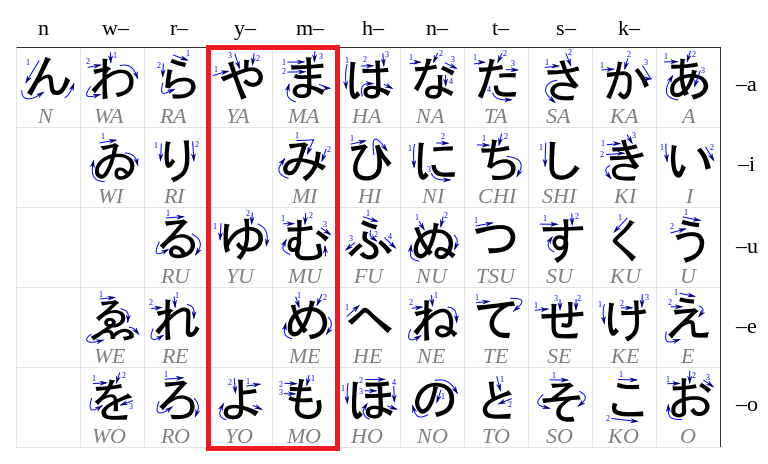Overview

Hello everyone! I hope you’ve all been keeping up thus far. In this lesson, we will be going through the 7th and 8th columns of the Hiragana chart, as well as diphthongs that can be produced.
Hiragana – Seventh Column
The seventh column is associated with the ‘m’ sound, so the the first letter, ま, is read as ‘mah’, and so on.
1. 
2. 
3. 
4. 
5. 
Hiragana – Eighth Column
This column is associated with the ‘y’ sound, and is a special column because there are only three letters.
1. 
2. 
3. 
Diphthongs
The ‘y’ column can be used to produce diphthongs, or contracted sounds. Just like for doubled consonants, small versions of や, ゆ and よ are added after almost all consonants ending in the ‘i’ sound. The result is that the two letters are said together really quickly, so it is like the ‘i’ sound is replaced with the ‘ya’, ‘yu’ or ‘yo’ sound.
For example, for き (Ki), you can add small や, ゆ and よ to produce the diphthongs:
1. きゃ
Romaji: Kya
2. きゅ
Romaji: Kyu
3. きょ
Romaji: Kyo
Do click on the audio clips if you’re unsure on how to pronounce. Also, note that long vowels also work for diphthongs, so you can have words like きゅう and きょう. Also, for し and じ, the Romaji are written as Sha, Shu, Sho and Ja, Ju, Jo respectively (‘y’ is not included).
Example Words
Below are some words and phrases that can be formed by combining all the letters we’ve learnt thus far.
- きょう (Kyou) – Today
- だいじょうぶ (Daijoubu) – I’m fine
- まえ (Mae) – In front/before
- あと (Ato) – Behind/later
- いま (Ima) – Now
- いみ (Imi) – Meaning
- もし (Moshi) – If
- いもうと (Imouto) – Little sister
- ぎゃく (Gyaku) – Reverse
- しょうがっこう (Shougakkou) – Elementary school
- ちゅうがっこう (Chuugakkou) – Middle school
- きょうふ (Kyoufu) – Fear/Terror
- きゅうけい (Kyuukei) – Rest/Break
- やっと (Yatto) – Finally
- しょうせつ (Shousetsu) – Novel
Conclusion
In this lesson, we learnt the 7th and 8th columns of Hiragana, as well as diphthongs. If you have any questions, be sure to comment below. I hope to see you in the next lesson!

It’s hard to come by knowledgeable people about this subject, however, you
seem like you know what you’re talking about! Thanks
I’ve been browsing online more than 3 hours today, yet I never found any fascinating
article like yours. It is beautiful worth enough for me.
Personally, if all web owners and bloggers made excellent content as you probably did, the web will probably be a lot more useful than ever before.
Does your website have a contact page? I’m having trouble locating it but, I’d like to send you an e-mail.
I’ve got some recommendations for your blog you might be interested
in hearing. Either way, great website and I look forward to seeing it expand over
time. Howdy just wanted to give you a quick heads up. The words in your content
seem to be running off the screen in Ie. I’m not sure if this is a format issue or something to
do with internet browser compatibility but I thought I’d post to let you know.
The design and style look great though! Hope you get the problem fixed soon. Thanks http://foxnews.net
Terrific task with this article. You constantly share fantastic information.
I just like the helpful info you supply in your articles.
I’ll bookmark your weblog and take a look at again right here
regularly. I am quite sure I’ll learn many new stuff right here!
Good luck for the following!
What a fantastic post! I require to share this with pals.
Excellent job with this short article. You always share excellent info.
Thanks for this nice post. …
I have been surfing online greater than three hours these days,
but I never found any interesting article like yours.
It is beautiful value enough for me. In my
opinion, if all site owners and bloggers made just right content as you probably
did, the internet shall be much more helpful than ever before.
I’m very pleased to uncover this web site. I want to to thank you for your time just for this wonderful read!! I definitely loved every part of it and i also have you book-marked to look at new information on your web site.
Heya i’m for the first time here. I found this board and I
find It trily useful & it helped me out a lot.
I hope to give something back and help others like you aided me.